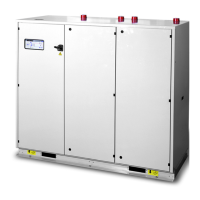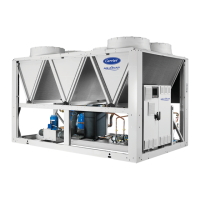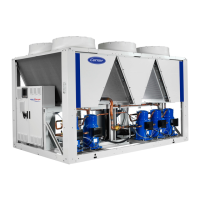
Do you have a question about the Carrier Aquasnap 30RW and is the answer not in the manual?
| Refrigerant | R-134a |
|---|---|
| Compressor Type | Scroll |
| Operating Range | -10°C |
| Sound Performance | Low noise operation |
| Energy Efficiency | High energy efficiency |
Guidelines for safe unit installation, including initial inspection and handling.
Instructions not to cover protection devices and classification of protection.
Information on components operating under pressure and testing.
Safety precautions for personnel performing maintenance on electrical and refrigeration parts.
Key information on refrigerant type, GWP, and periodic checks of protection devices.
Safety procedures for repairing the unit, including refrigerant handling and leak tests.
Inspection procedure for received equipment to ensure completeness and absence of damage.
Guidelines for safely moving and positioning the chiller unit.
Detailed physical dimensions for standard units without hydronic modules.
Physical dimensions for units with optional hydronic modules or option 116E.
Physical dimensions for units with or without hydronic modules in the 060-150 range.
Physical dimensions for standard units without hydronic modules in the 160-300 range.
Physical dimensions for units with optional hydronic modules in the 160-300 range.
Table detailing physical specifications like cooling capacity, weight, and refrigerant charge.
Electrical specifications including voltage, current draw, and power input for various models.
Electrical data specific to the pumps in optional hydronic modules.
Specifies the operating limits for 30RW/RWA units under various conditions.
Defines the operating range for 30RW units based on water temperatures.
Defines the operating range for 30RWA units based on air temperatures.
Specifies the minimum required chilled water flow rate for stable operation.
Details the maximum chilled water flow rate to avoid pressure drop issues.
Guidance on using variable evaporator flow for constant leaving water temperature.
Table showing minimum and maximum evaporator flow rates for different models.
Specifies minimum and maximum condenser water flow rates.
Formula and table for calculating minimum chilled water loop volume.
Table for maximum water loop volume for hydronic units.
Guidance on calculating minimum hot water loop volume for heat pump operation.
Graphical representation of pressure drops in water circuits based on flow rate.
Diagrams and notes on electrical connections for 30RW/30RWA units.
Specifications for power supply voltage, range, and warnings about imbalance.
Procedure for calculating and assessing voltage phase imbalance.
Table and guidelines for selecting minimum and maximum wire sections for power connection.
Information on field control wiring for various unit features and interface.
Key precautions for water circuit design, installation, and filling.
General guidance on water pipe connections and circuit filling.
Recommendations for antifreeze solutions and protection against freezing temperatures.
Installation and connection requirements for the evaporator flow switch and pump interlock.
Guidelines for installing split units with remote air-cooled condensers.
Constraints and considerations for refrigerant pipe sizing, including oil return.
Procedure for estimating cooling capacity based on pipe diameter and length.
Methods for sizing discharge piping to ensure reasonable pressure drops.
Considerations for liquid line sizing, including pressure drops and subcooling.
Step-by-step guide to adjusting the water flow rate using the control valve.
Graphical representation of evaporator pump performance characteristics.
Curves showing available static system pressure for evaporator pumps.
Graphical representation of condenser pump performance characteristics.
Curves showing available static system pressure for condenser pumps.
Overview of the 30RW unit's operation using drycoolers for heat rejection.
Description and function of the AUX1 board for drycooler control.
Instructions for configuring fan stages and automatic changeover for drycoolers.
Guidelines for assigning fan stages for optimal drycooler operation.
Overview of 30RWA unit operation with remote air-cooled condensers.
Explanation of the master fan's role in air-cooled condenser systems.
Description of separate vs. interlaced ventilation for dual-circuit condensers.
Function of the AUX1 board for controlling remote air-cooled condensers.
Configuring fan stages and types based on the remote condenser model.
Illustrations of fan arrangements for different condenser types and configurations.
Essential pre-start checks for the chiller unit and connected systems.
Step-by-step guide for the commissioning and initial start-up of the chiller.
Configuration and operation of units in a master/slave setup.
Details on compressor type, operating limits, and safety precautions.
Information on compressor lubricant type, handling, and oil level checks.
Description of plate heat exchangers used as evaporators and condensers.
Information on the thermostatic expansion devices and their settings.
Details on the refrigerant used (R-407C) and its properties.
Function and operation of the safety high-pressure switch.
Information on safety valves and their compliance with directives.
Purpose and function of the moisture indicator in the liquid line.
Role of the filter drier in maintaining circuit cleanliness and moisture control.
Description of the fixed-speed evaporator pump and its performance.
Guidelines and safety for soldering and welding operations on the unit.
Routine cleaning and inspection tasks for maintaining the unit.
Procedures for checking and verifying the refrigerant charge level.
General practices for handling refrigerants to minimize discharge and losses.
Methods and precautions for detecting refrigerant leaks in the system.
Steps and requirements for safely evacuating the refrigerant system.
Procedure for recharging the system with liquid refrigerant.
Table detailing saturated bubble and dew point temperatures for R-407C.
Checks for electrical connections, contactors, and components.
Preventive maintenance checks recommended for compressors.
Maintenance recommendations for heat exchangers, including insulation checks.
Procedures for periodically checking the unit's coating for corrosion.
Scheduled maintenance tasks based on service intervals (A, B, C, D).
Detailed description of maintenance tasks for each service level.
Fields for job name, location, contractor, and distributor details.
Checks for shipping damage and verifies unit installation status.
Verification of air handling units, water valves, and fluid piping.
Steps for unit start-up, including pump interlock and valve status.
Checks for water loop volume, corrosion inhibitor, and freeze protection.
Procedure for measuring pressure drop across the evaporator.
Instructions to perform and verify the positive result of the TEST function.
Steps to initiate chiller operation after all checks are completed.
Recording key operating temperatures and pressures after stabilization.
Important note regarding refrigerant label and F-Gas regulation procedure.











